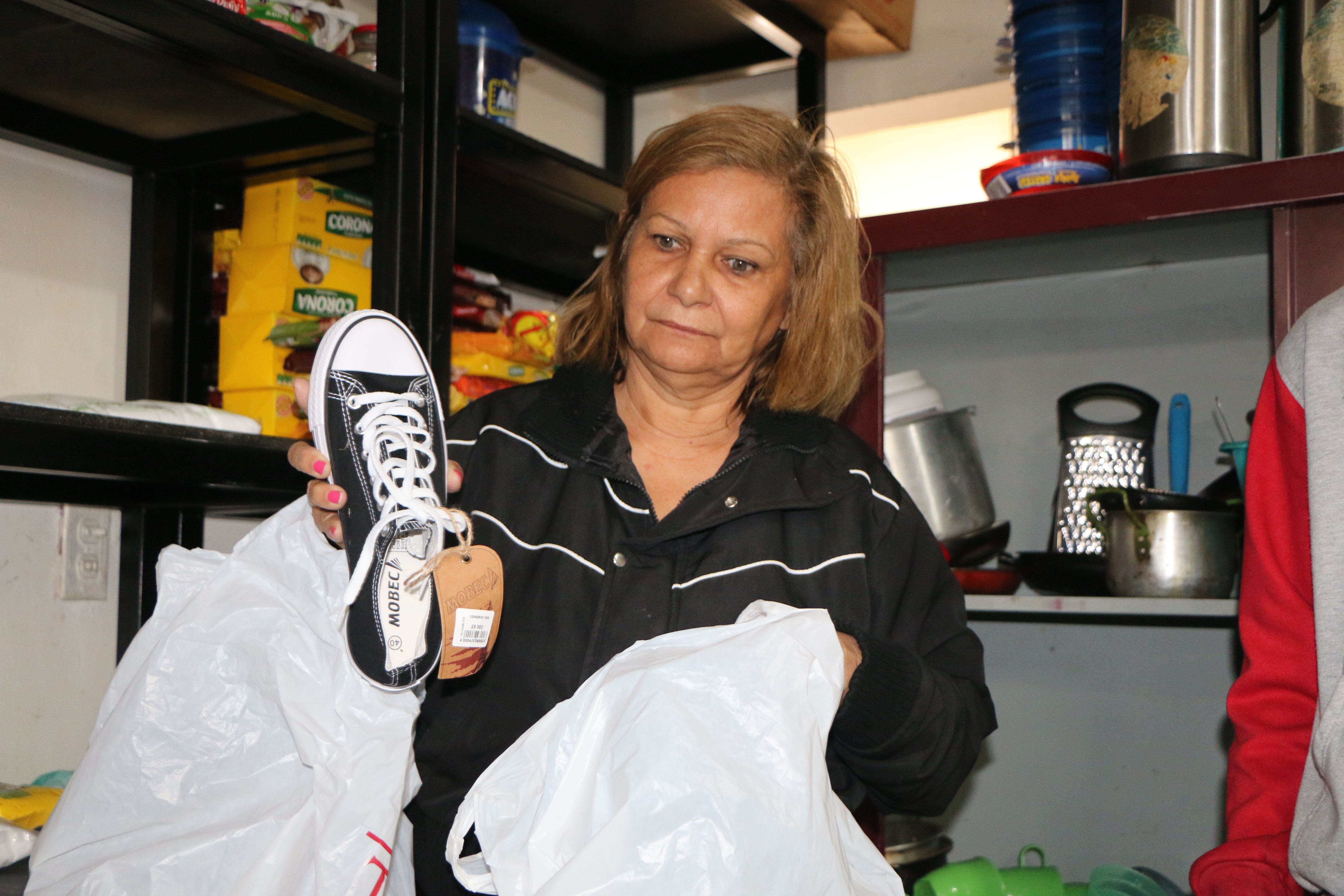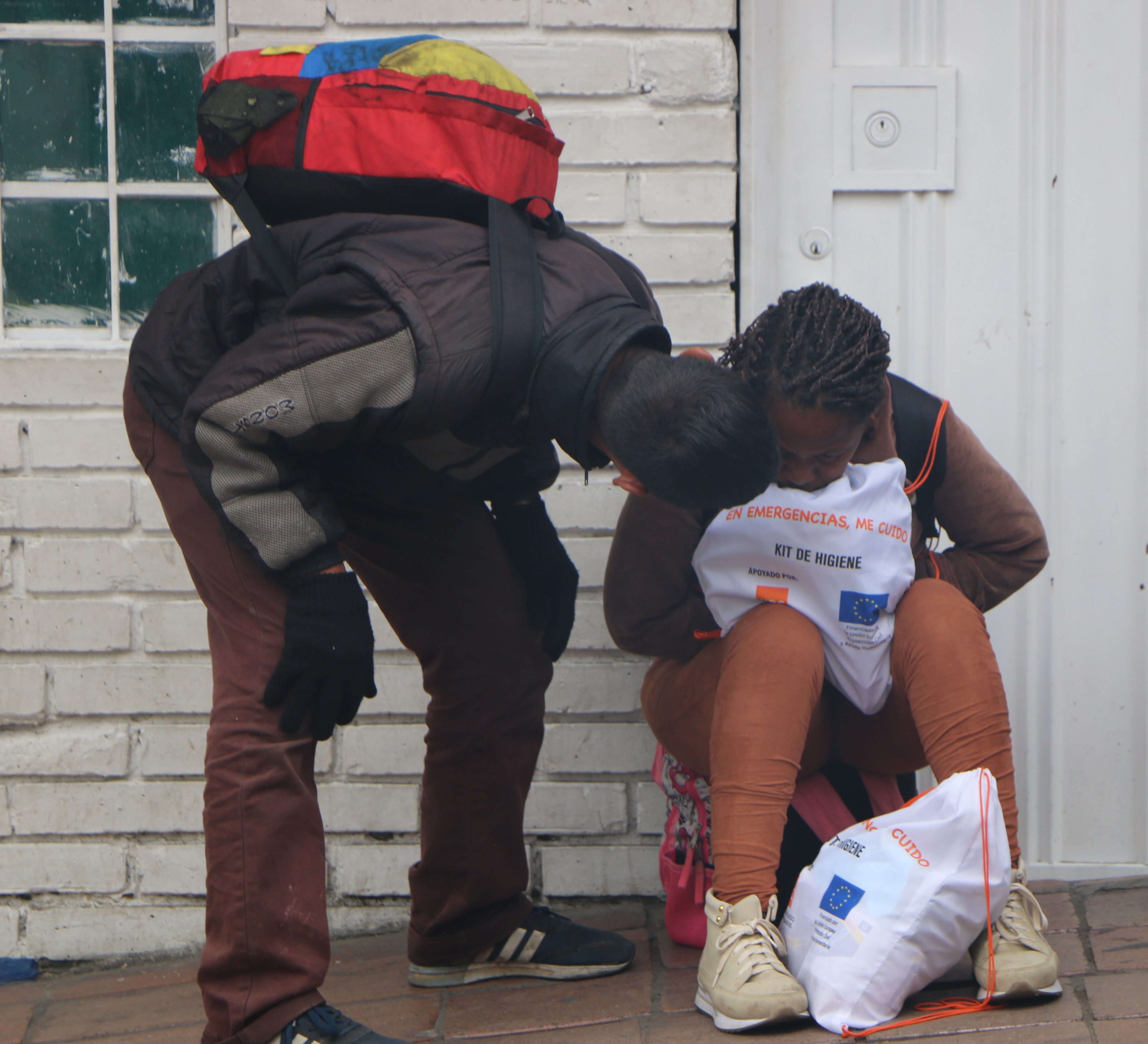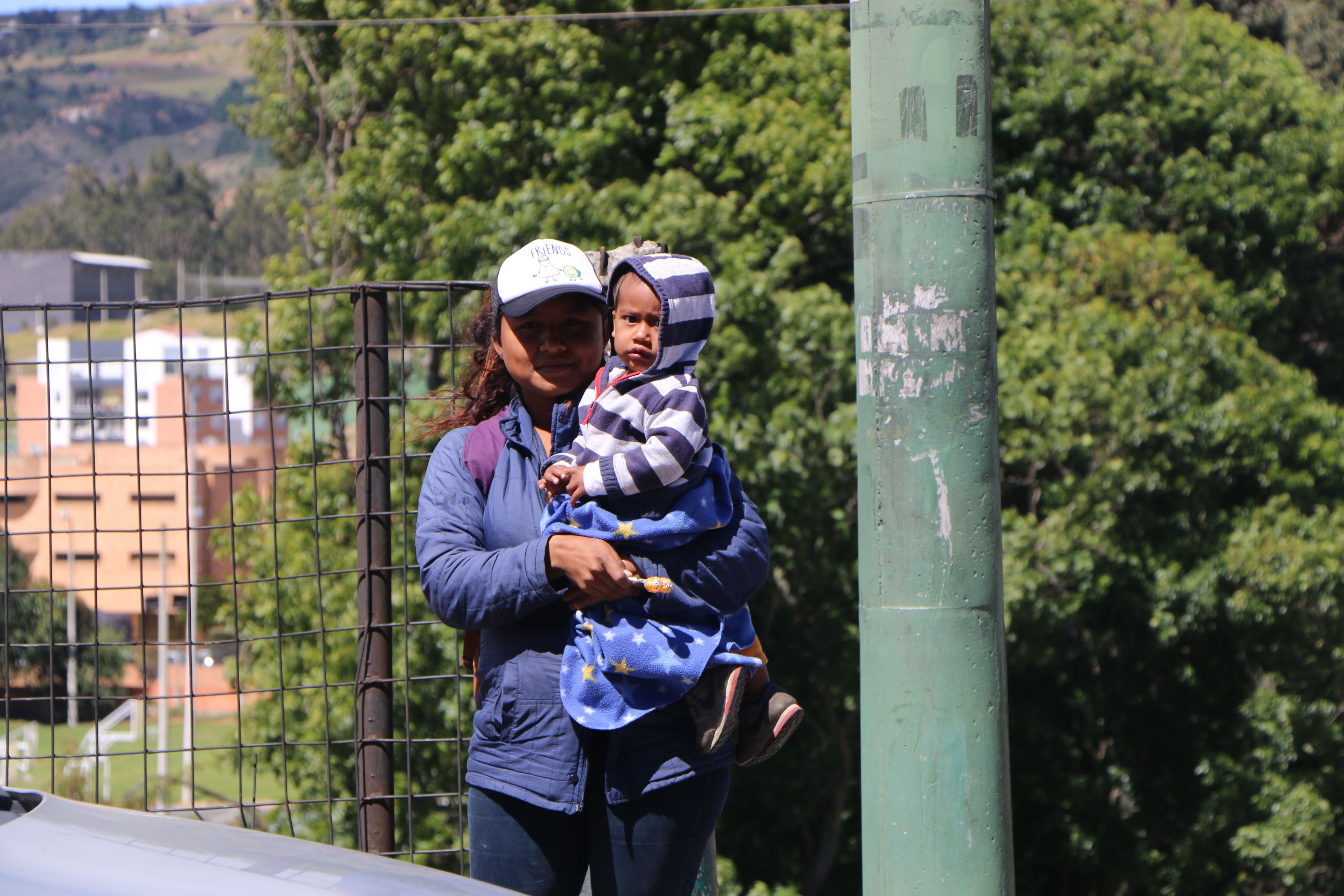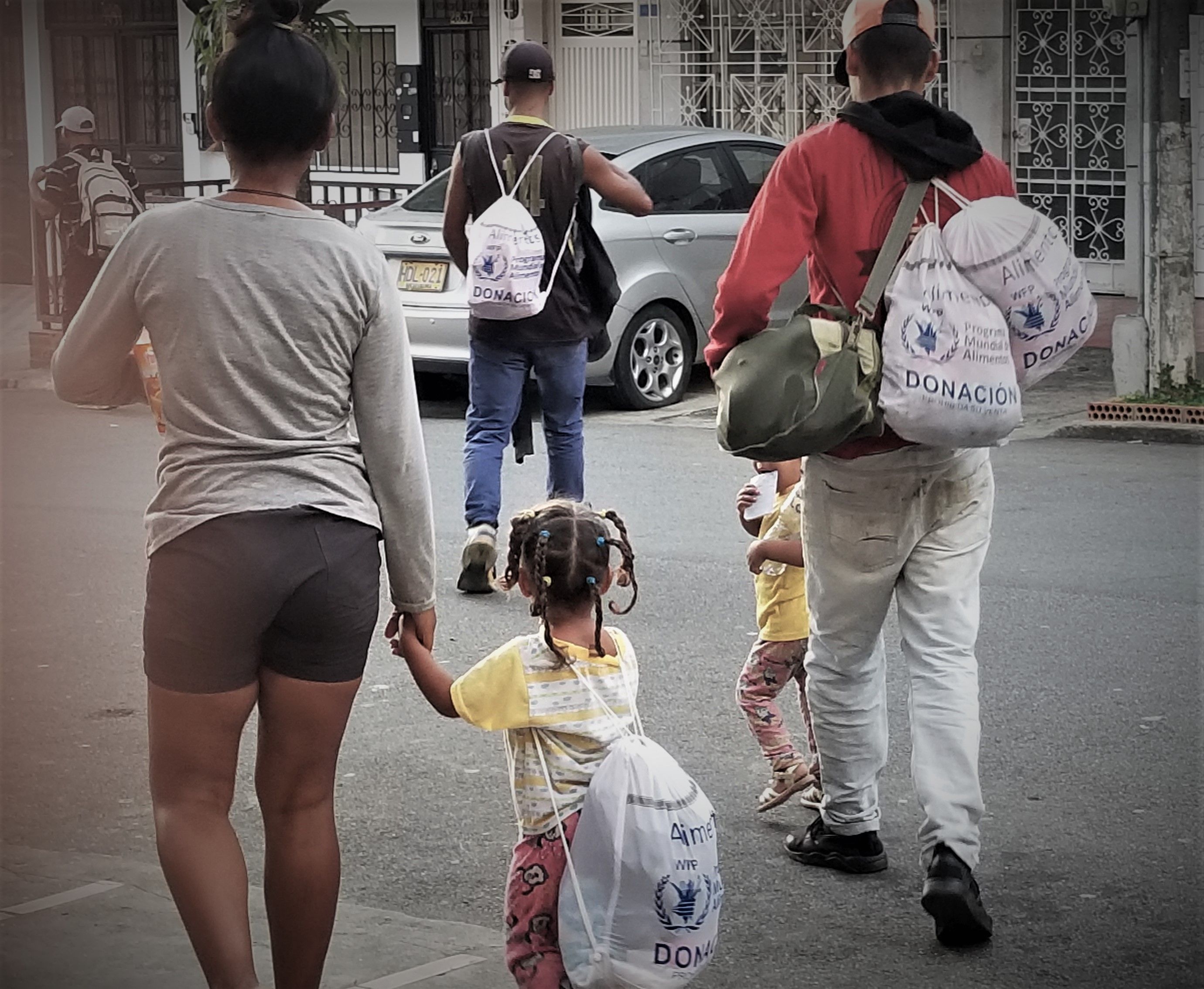“If you had been here yesterday you would have seen the feet of a little 4-year-old, they were completely destroyed,” says Annie Uribe.
Uribe sits in the small office of her home, from which she operates the shelter for Venezuelan refugees next door. Uribe has received hundreds of people in similar conditions, feet bloody and covered in blisters, wounds untreated for days, people sick from sleeping outdoors in the cold.
“Women are risking themselves,” she says. “The mothers are saying, ‘I have to save my child in some way, and I prefer to die trying instead of staying here.’”
Uribe, a Venezuelan immigrant living in Central Colombia, founded this shelter in order to assist thousands of refugees like this girl who are fleeing the deteriorating conditions of neighboring Venezuela. Traveling on foot, they are now visible on highways throughout Colombia, even in small towns like Uribe’s home of Tunja. They are called caminantes, Spanish for “the walkers.”
An Overlooked Passage
Annie Uribe runs the only shelter in Tunja. The town is situated where two of the main highways that lead from the Colombian-Venezuelan border converge and continue on to Colombia’s capital of Bogotá. It is a small, working class town high in the mountains of central Colombia.
“Tunja is an unavoidable transit area for anyone crossing Bogota in order to go to Ecuador, Peru, Chile, Argentina, even Bolivia,” Uribe goes on, “Unfortunately, in the municipalities everything is under the discretion of the mayors ... We haven't received any help as such thus far.”
Tunja has never received migrants like this. Like many parts of Colombia, it is a place from which people have historically migrated for economic reasons or due to insecurity during Colombia’s armed conflict. It has never been a place that has received migrants from elsewhere in large numbers. That all changed within the past few years as Venezuelan people have begun to leave their country in mass due to increasing political and economic stability.
“We opened on July 28, 2018, at seven in the evening,” recalls Uribe. “At 20 past seven, we had 60 caminantes in the shelter and we had neither publicity nor anything. After an hour and a half, we had 136 people on the first night: no mattresses, no sheets, nothing. My husband, a friend, and I went to look for recycling cardboard, and those were their mattresses.”
More than 4 million Venezuelans have left their country since 2015, and that figure is projected to grow to over 8 million in 2020 according to the Organization of American States, putting it on track to soon become the largest refugee crisis in the world. Meanwhile, international aid for Venezuelan refugees has lagged well behind aid for other refugee crises around the world. For example, international aid per capita for Syrian refugees is $5,000, while for Venezuelans it is only $100 per person.
The effects of this lack of aid can be seen even in central Colombia, hundreds of miles from the border. In cities in the interior such as Tunja, much of the care for Venezuelan migrants falls on ordinary people.
Hanging On
The volunteers in Uribe’s shelter, nearly all themselves Venezuelan immigrants, cook hot meals, clean the shelter, and organize whatever donations come in. Today, the volunteers are in good spirits. Yesterday the stocks of food were nearly gone—the shelter relies on donations from local stores and merchants—but last night a large donation was dropped off, ensuring enough food for the next few days.
When the caminantes arrive for the night, women are shown to the dormitories upstairs, men to the lower level. Women with children stay in the house next door—a recent addition to address the growing need for space for families.
Maria Isabel Parez Lopez, 18 years old, is walking with her baby who is less than a year old. She also walks with her husband and her sister, who has a disability. They left Venezuela together after they could no longer afford to buy food.
“With what my husband earned—he was a baker—with what he earned in a week, it was only enough for flour. And we were eating yucca and plantains, so that our child wouldn’t get sick in his stomach. It wasn’t enough food,” says Lopez. She and her family have already walked over 250 miles to reach the shelter, walking on the shoulder of the highway and sleeping outdoors.
“I don’t worry about myself but I worry for my child,” says Lopez.
Over the past year Uribe has seen a large increase in mothers traveling with children arriving in Tunja.
“This year, we have served more than 18,000 people,” said Uribe. “In the last four months, practically the 60 percent of the population have been underage,” says Uribe. These families are vulnerable to robbery or violence while walking alone. An August 2019 report revealed an increase in violent killings of Venezuelans in Colombia so far this year.
“The situation is really hard,” recalls Lopez. “We can’t walk on the streets at night because we get robbed— [robbed] by the same Venezuelans—because they can’t find food or anything.”
The men’s dormitory next door is more rowdy. Forty men are crammed into a small dormitory in bunkbeds. They joke and talk about the situation in Venezuela. Many have left their families behind to search for work in foreign countries.
“I have eight children. And unfortunately, my wife has to work, my two oldest sons have to work, and I have to work. I had to leave the country and my family split apart. I have been separated from my wife for two years," says 41-year-old Jorge Luis Fambrero Alambare. “I blame that on the government.”
Some of them talk Venezuelan politics and get into the subject of president Maduro. Nearly every caminante at the shelter believes Maduro’s policies are to blame for their situation.
“I consider him more than a dictator,” says Alambre, “Venezuela was the richest nation in South America. And now it’s the worst nation in South America.”
Alambre hopes he will someday return to Venezuela, after the crisis is over.
Dinner is served outdoors, and everyone gathers. Tonight, there is a plate of rice, beans, and yucca, with a bowl of cornflakes for dessert. Hennison Morales, her mother, and her infant daughter Albanis are giddy over the bowl of cornflakes—it is the first Morales and her mother have seen them in a long time. There is consensus that this is the best shelter they’ve had in the eight days walking from the border. At least tonight they won’t be sleeping on the ground.
“The others [shelters] don’t have beds like these to sleep on. We didn’t have things to shower. There are some that didn’t have a place to shower. They wouldn’t give food. And sometimes they wouldn’t help us with the kids, with diapers and things like that, but this one is really good.”
Albanis, Hennison’s baby, got sick during their trip, but they were able to receive treatment for her in a Colombian hospital and continue walking. They remain optimistic, inspired by little things like the bowl of cornflakes.
“In Venezuela there is nothing,” she says. “The children are dying of hunger, and for lack of medicine.”
Apart from the risk of illness and injury along the road, the climate of Tunja is especially cold. In the night temperatures reach the low 40s. Many of the walkers who have come from the tropical climate along the border do not have clothes for the cold weather. Some have died of cold along on the road from Venezuela.
“I think climate is the worst enemy for the caminante,” says Uribe. “The caminante that is coming from such a warm place—from such tropical climate … It’s a travesty. It’s life threatening.”
By 8pm, the shelter is full for the night. Those who arrive now are told there is no more room. Some sleep on the sidewalk down the street, huddled against a wall that protects them from the biting wind.
After dinner, the caminantes are exhausted and go straight to bed. The volunteers stay up and talk about the day, the shelter, or the situation in Venezuela.
They’ve heard news that the foundation serving Venezuelans in Bucaramanga has been forced to relocate due to an order of city’s mayor’s office. Bucaramanga lies on one of the highways between Tunja and the border. The foundation there is one of the only organizations working with caminantes on the route to Bogotá, and many of the caminantes here in Tunja got what little they had thanks to the foundation in Bucaramanga.
The volunteers are unsure if the foundation in Bucaramanga will remain open—and if they will be able to find the money to rent another space. The volunteers worry their own shelter will not last. They are struggling to come up with money to pay the rent and electricity for the next month. Many of them do not have permits to work in Colombia themselves and are unable to find jobs here to help pay the shelter’s costs.
The Journey Continues
The next morning, after a hot breakfast, people continue to walk, with hopes of reaching family or places they’ve been told about across Latin America. So far, they have traveled less than half way across Colombia.
“I will walk to Ecuador because I want to show my family that it can be done,” said Ramon Coban, a 46-year-old caminante continuing on his journey. “When you want to fight for your family, when you want to fight for the future of your children, you can make that sacrifice.”
There is nothing orderly about the journeys of the caminantes—they arrive in Tunja at all hours of the day and night. Some intend to go to Ecuador or Peru, others even farther to Chile or Argentina. Some people do not continue walking and decide to stay in towns like Tunja.
As the last night’s cohort is leaving, a new caminante knocks on the door wearing only a t-shirt and jeans. He is shivering from walking all night. The backpack he had been carrying was stolen while crossing the border, and now he has nothing with him but the clothes on his back. He asks about getting into the shelter, and is turned away. The shelter does not open again for nine more hours, and there is no other place in Tunja to go.
Here To Stay
A few blocks from the shelter, Denyis Del Valle Millan Frontado works on a street corner with two other Venezuelan women and their children, selling candies or simply asking for money from passers-by. She has been living in Tunja for four months. Because she does not have a work permit, working on a street corner is the best option for her to make enough money to eat.
For many of those who are staying in Tunja, there are few resources like the shelter that can help them other than the charity of strangers. Frontado hoped for more.
“I wanted help as well—to be able to work on my own,” said Frontado, “But [NGOs] are only giving help to those that have children. Well, I have daughters, I have two. One that is three and one that is seven, but they’re in Venezuela.”
Begging for money or selling candy on the street corner may not make much money, but is more than some people are able to make in Venezuela due to the hyperinflation of the Venezuelan currency. Frontado keeps working here so that she can support her children in Venezuela. “My daughters don’t have anything, anything at all,” she said.
Many caminantes plan to travel to other parts of Latin America, although that may be changing soon. Chile, Ecuador and Peru have all passed recent policies to make it more difficult for Venezuelan migrants to enter without a visa. These policies will affect the most vulnerable migrants such as the carminates.
Venezuelans who stay in Colombia do not have many doors open to them to make money. Frontado points to a mother and her child who are begging for money from the drivers of passing cars.
“Those [Venezuelans] have to be day in and day out at a traffic light to see if they make enough to at least half eat something, and to see if they have enough to be able to sleep in a hotel,” she says. “It’s tremendously hard.”
Uribe hopes the shelter will stay open, but worries that they will not have enough to pay the shelter’s utilities this month. The shelter operates without any government assistance, and there are few resources for NGOs like hers. The world is not seeing the toll the Venezuelan crisis is taking on regular people, she argues.
“I, as a mother and as a grandmother, would not want to see my grandchildren die in Venezuela from the lack of a pound of rice … [in Venezuela] you don't have access to medicine, you don't have access to food,” says Uribe.
“I think we must make visible that the crisis that exists in Venezuela is humanitarian.”













